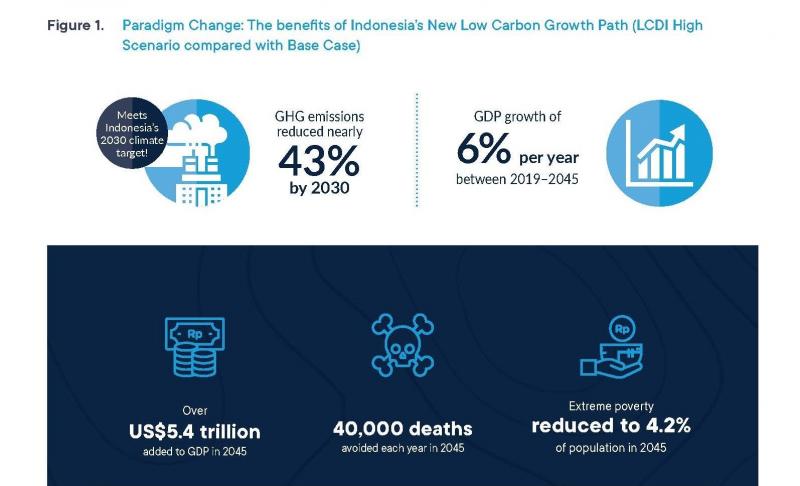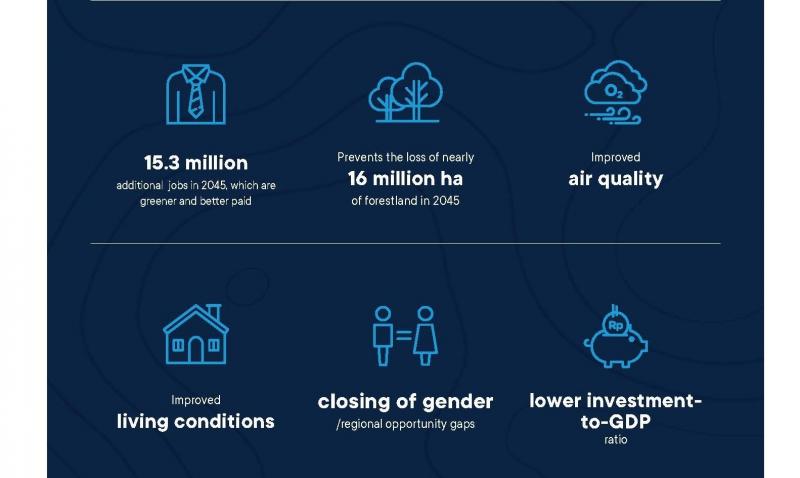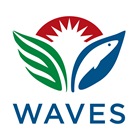
(Left-Right) Adi Lumaksono, Principal Secretary of BPS hands over two technical reports of the I-WAVES program to Dr. Ir. Arifin Rudiyanto, Deputy Minister of Maritime and Natural Resources of Bappenas
Indonesia has enjoyed steady economic growth and significant socio-economic progress in the last few years. With agriculture, forestry and fishing contributing 11.4% to GDP, this development is heavily dependent on natural resources. The Government of Indonesia is increasingly aware of the contribution of natural capital and has pledged to deliver on the country’s Nationally Determined Contribution (NDC), achieve the Sustainable Development Goals (SDGs), and green Indonesia’s growth trajectory.
In 2017, The Ministry of National Development Planning (BAPPENAS), in cooperation with the World Bank and several development partners introduced the Low Carbon Development Initiative for Indonesia (LCDI) to explicitly incorporate GHG emissions reduction targets into the country’s National Medium-Term Development Plan (RPJMN) 2020-2025, along with other interventions for preserving and restoring natural resources.
As the new platform for Indonesia’s development, LCDI allowed the government to understand ways to maintain economic growth while minimizing exploitation of natural resources and keeping the emissions low. The LCDI helps the policy-makers prioritize development policy interventions that reduce emissions or build climate resilience. One of the key findings of the LCDI report is that a low carbon growth path can deliver an average GDP growth rate of 6% annually until 2045. By sustainably using natural resources, and by reducing its carbon and energy intensity, Indonesia’s total GHG emissions can fall by nearly 43% by 2030 (see graph below).
Technical assistance provided by WAVES provided System of Environmental Economic Accounting (SEEA) compliant data that could be used for systems dynamic modelling vital to LCDI. Data from natural capital accounts on land cover and extent accounts, as well as peatland accounts proved to be useful in running the models that informed LCDI. The models analyzed the carrying capacity of the natural systems under different growth scenarios and showed how growth could be constrained by the limits of natural capital to provide ecosystem services. This represents one of the main contributions of WAVES to Indonesia’s policy making, as this work underpins decisions that will be made in the next five-year policy cycle.
This point was emphasized by Dr. Ir. Arifin Rudiyanto, the Deputy Minister for Maritime Affairs and Natural Resources of BAPPENAS at the closing event of the WAVES Program attended by over 150 key high-level officials from various government agencies, academicians, NGO/CSOs, private sectors and media on Friday, July 26, 2019,
“The WAVES program has supported us in mainstreaming natural capital accounting into our development planning. The innovative approaches and solutions employed by this program enabled us to integrate natural capital accounting into our low-carbon development planning and brings us closer to our Sustainable Development Goals.”
The next phase of WAVES work in Indonesia will be in line with the new thinking that the Global Program for Sustainability (GPS), successor of WAVES program, has brought to the table. The program will be working on economy-wide options for improved land use planning for protection of peat, and coastal resources including mangroves. "The next phase of work will help support implementation of key policies engrained in the Medium-term Development Plan by assessing the merits of alternative options for managing natural capital by looking not only at monetary gains from increasing output, but by considering the effects of a cleaner environment on human well-being.’’ explained Raffaello Cervigni, Program Coordinator for WAVES and GPS.


